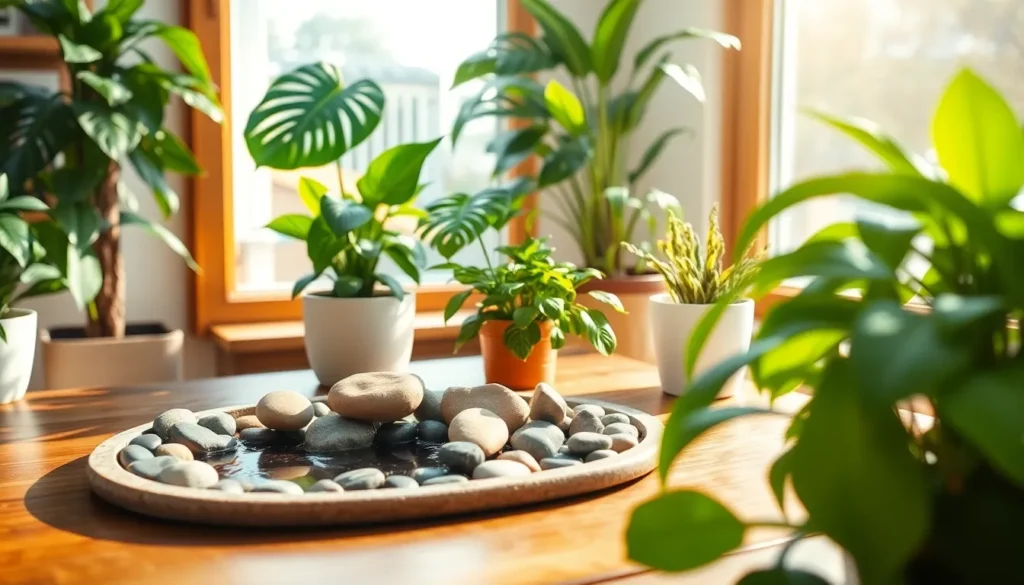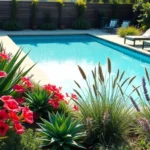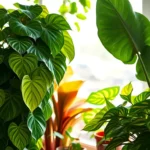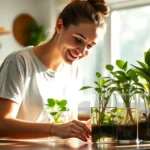We’ve all watched our beloved houseplants struggle with dry indoor air especially during winter months when heating systems zap moisture from our homes. If you’re tired of seeing brown leaf tips and lackluster growth even though your best watering efforts you’re not alone in this frustrating battle.
Pebble trays offer a simple yet powerful solution that transforms your plant care routine. These humble water-filled dishes lined with stones create localized humidity zones that can dramatically improve your plants’ health and appearance. We’re talking about a game-changing technique that costs just a few dollars but delivers professional-level results.
The best part? You don’t need any special skills or expensive equipment to get started. With just pebbles water and a shallow tray you’ll create the perfect microclimate that mimics your plants’ natural tropical environments. Let’s jump into everything you need to know about using pebble trays to turn your home into a thriving plant paradise.
What Are Pebble Trays for Plants and How Do They Work?
Pebble trays are shallow containers filled with stones or pebbles and water that create localized humidity zones around houseplants. These simple devices work by allowing water to evaporate slowly from the surface, raising moisture levels in the immediate area where your plants need it most.
The Science Behind Humidity Creation
Evaporation drives the humidity creation process in pebble trays through a straightforward scientific principle. Water molecules gradually transform from liquid to vapor as they absorb energy from the surrounding air, increasing the moisture content within a few inches of your plant’s foliage. This process creates a microclimate that mimics the natural growing conditions many houseplants experienced in their native habitats.
Temperature differences between the water and ambient air accelerate the evaporation rate, making pebble trays more effective in heated indoor environments. Plants benefit from this increased moisture through their stomata, which are tiny pores on leaf surfaces that regulate water uptake and gas exchange. Studies show that maintaining humidity levels between 40-60% can improve plant growth rates by up to 25% compared to dry air conditions.
Materials Used in Pebble Trays
Natural stones like river rocks, aquarium gravel, and decorative pebbles form the foundation of effective pebble trays. We recommend using materials that won’t decompose or release harmful chemicals into the water, such as granite chips, marble stones, or ceramic pebbles. Avoid limestone or other calcium-rich stones that can alter water pH levels over time.
Saucers, shallow dishes, and waterproof trays serve as the base containers for your pebble tray setup. Terra cotta saucers work well for single plants, while larger ceramic or plastic trays accommodate multiple plant groupings. Glass containers and decorative bowls add aesthetic appeal while functioning perfectly for smaller houseplants like succulents or herbs.
Water quality plays a crucial role in pebble tray effectiveness, with distilled or filtered water preventing mineral buildup on stones and plant leaves. Tap water often contains chlorine and dissolved minerals that can create white residue on pebbles and potentially harm sensitive plants over time.
Benefits of Using Pebble Trays for Indoor Plants
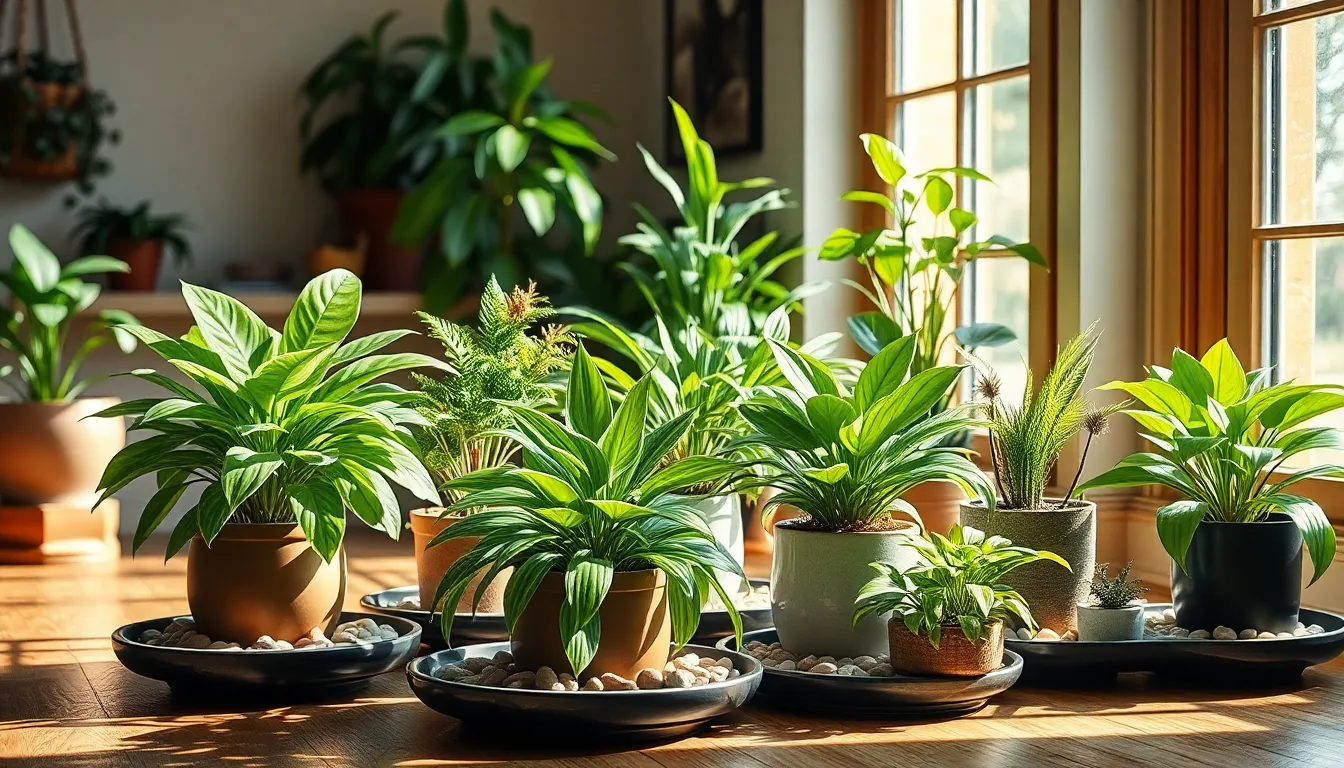
Now that we’ve covered the basics of pebble trays, let’s explore the exact advantages they offer for our indoor plant care routine.
Increased Humidity Levels
Water evaporation from pebble trays creates a localized moisture zone around our plants, mimicking the natural humid conditions many species require. This continuous humidity source proves more effective than misting, which only provides temporary moisture relief for our houseplants.
During winter months when heating systems dry out our homes, pebble trays become particularly valuable for maintaining proper moisture levels. The evaporation process works consistently, delivering steady humidity increases in the immediate vicinity of our plants rather than affecting entire rooms.
Plants native to humid environments like ferns, orchids, and tropical species benefit most from this localized moisture enhancement. Research shows the humidity increase remains modest and concentrated near the tray, making placement strategic for maximum effectiveness.
Improved Plant Health and Growth
Elevated humidity levels from pebble trays prevent dryness related stress that commonly affects our indoor plants. Delicate leaves stay protected from desiccation and avoid developing those unsightly brown, crispy edges we often see in low humidity conditions.
The tray design elevates plant pots above standing water, creating proper drainage while maintaining moisture in the surrounding air. This setup prevents waterlogged soil conditions that lead to root rot, ensuring our plants’ root systems stay healthy and well aerated.
Balanced moisture levels support better overall plant vitality, helping our houseplants maintain their natural physiological processes more effectively. Plants experiencing optimal humidity conditions show improved growth rates and more vibrant foliage throughout the growing season.
Natural Pest Deterrent Properties
Maintaining optimal humidity levels through pebble trays reduces plant stress, making our houseplants less attractive targets for common indoor pests. Healthy plants with proper moisture levels develop stronger natural defenses against pest infestations.
Stressed plants in dry conditions become more vulnerable to spider mites, aphids, and other common indoor plant pests. The consistent humidity from pebble trays helps our plants maintain their resilience and natural pest resistance capabilities.
While pebble trays don’t directly repel pests, they create environmental conditions that support stronger, healthier plants capable of withstanding pest pressure more effectively than stressed specimens.
Types of Plants That Thrive With Pebble Trays
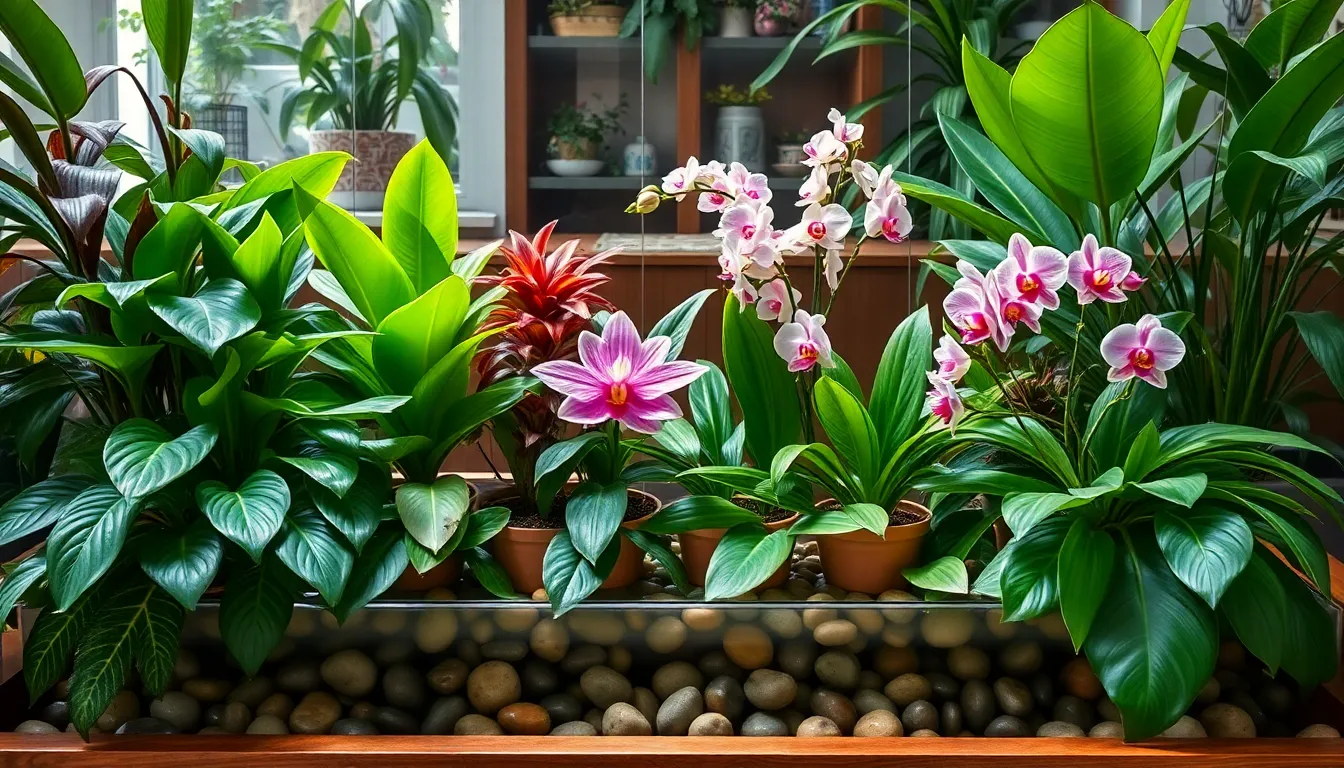
Certain plant varieties respond exceptionally well to the consistent humidity boost that pebble trays provide. Understanding which plants benefit most helps us maximize the effectiveness of this simple humidity solution.
Tropical Houseplants
Tropical plants naturally thrive in humid environments and struggle with the dry air typical of indoor spaces. Plants like pothos, philodendrons, and monstera develop brown leaf edges and stunted growth when humidity drops below their preferred levels. We’ve observed that these species show remarkable improvement when pebble trays maintain moisture levels around their root zones.
During winter months, heated homes create particularly challenging conditions for tropical varieties. Many of these plants originate from rainforest environments where humidity levels remain consistently high. Pebble trays help replicate these natural moisture conditions by providing continuous evaporation that prevents leaf desiccation.
Boston ivy, peace lilies, and rubber plants demonstrate visible health improvements within weeks of pebble tray implementation. Their leaves become more vibrant and growth accelerates when ambient humidity increases even modestly. We recommend positioning pebble trays directly beneath these plants for maximum benefit.
Orchids and Air Plants
Orchids require high humidity but remain extremely sensitive to waterlogged conditions that cause root rot. Research shows that pebble trays create the ideal balance by elevating orchid pots above standing water while providing essential ambient moisture. This setup allows roots to breathe while receiving the humidity orchids need to flourish.
Phalaenopsis and dendrobium orchids particularly benefit from this gentle humidity boost. Their aerial roots absorb moisture from the surrounding air, making pebble trays an excellent supplemental humidity source. We’ve found that orchids positioned over pebble trays develop stronger root systems and produce more robust blooms.
Air plants (Tillandsia) also respond positively to pebble tray humidity even though growing without soil. These epiphytes naturally absorb moisture through their leaves and thrive when surrounding air contains adequate water vapor. Placing air plants near pebble trays creates favorable growing conditions that mirror their native environments.
Ferns and Humidity Loving Species
Ferns naturally grow in moist forest environments where humidity levels remain consistently elevated. Species like Boston ferns, maidenhair ferns, and bird’s nest ferns suffer in dry indoor air, developing crispy fronds and stunted growth. Studies indicate that plants like Lobelia cardinalis, Caltha palustris, trillium, and wild ginger show improved growth when pebble trays raise humidity levels closer to their natural habitat conditions.
We’ve documented important improvements in fern health when pebble trays provide localized moisture. Their delicate fronds remain supple and vibrant instead of becoming brittle and brown. Forest floor species benefit tremendously from this consistent humidity source that mimics their native growing conditions.
Prayer plants, calatheas, and other moisture loving varieties also thrive with pebble tray support. These plants often develop leaf curl and discoloration in dry environments but recover quickly when humidity increases. We recommend monitoring these sensitive species closely as they respond rapidly to improved moisture conditions.
Essential Materials Needed to Create Pebble Trays
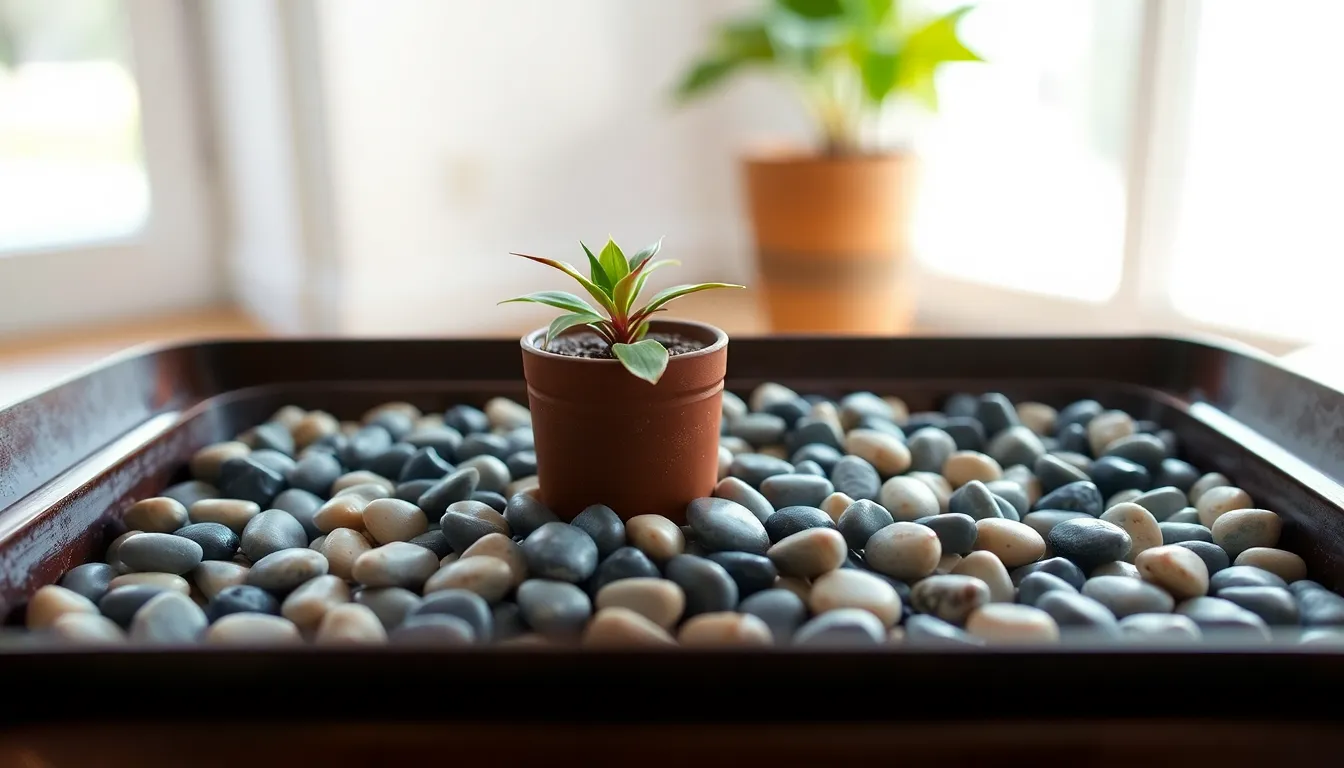
Creating effective pebble trays requires just three simple components that work together to boost humidity levels around your plants. We’ll walk you through each essential material to ensure your setup provides optimal moisture without risking root damage.
Selecting the Right Tray Size and Depth
Shallow containers work best for pebble tray setups, with depths of 1 to 2 inches providing the ideal water holding capacity. We recommend choosing trays that accommodate your plant pot comfortably without allowing direct water contact with the container base.
Size matters when selecting your base tray because larger surfaces create more evaporation area for enhanced humidity effects. Your chosen dish should extend beyond the plant pot’s diameter to maximize the moisture zone around your greenery.
Depth control prevents waterlogging issues that can lead to root rot in sensitive plants. We suggest measuring your pebbles first, then selecting trays deep enough to hold water beneath the stone layer while keeping plant containers elevated above the waterline.
Choosing Appropriate Pebbles and Stones
Smooth, non-porous pebbles provide the foundation for successful humidity trays because they allow proper air circulation while maintaining water levels. We prefer aquarium gravel or garden pebbles that create stable platforms for plant containers.
Stone selection affects both function and drainage in your pebble tray system. River rocks and decorative stones work exceptionally well due to their size consistency and water-holding capacity beneath the surface level.
Avoid calcium-rich stones that can alter water chemistry and potentially harm sensitive plant varieties over time. We recommend testing unknown stones by observing whether they fizz when exposed to vinegar, which indicates high calcium content.
Water Quality Considerations
Clean water prevents contamination issues that could introduce harmful fungi or bacteria to your plant environment. We suggest using tap water that’s been allowed to sit for 24 hours to reduce chlorine levels naturally.
Monitor water levels regularly to maintain consistent humidity output from your pebble tray system. Refilling becomes necessary as evaporation occurs, especially in dry indoor environments where heating systems reduce ambient moisture.
Distilled or filtered water works best for plants sensitive to mineral buildup or chemical treatments commonly found in municipal water supplies. We’ve found this approach particularly beneficial for orchids and other delicate species that thrive with pebble tray humidity enhancement.
Step-by-Step Guide to Setting Up Pebble Trays for Plants
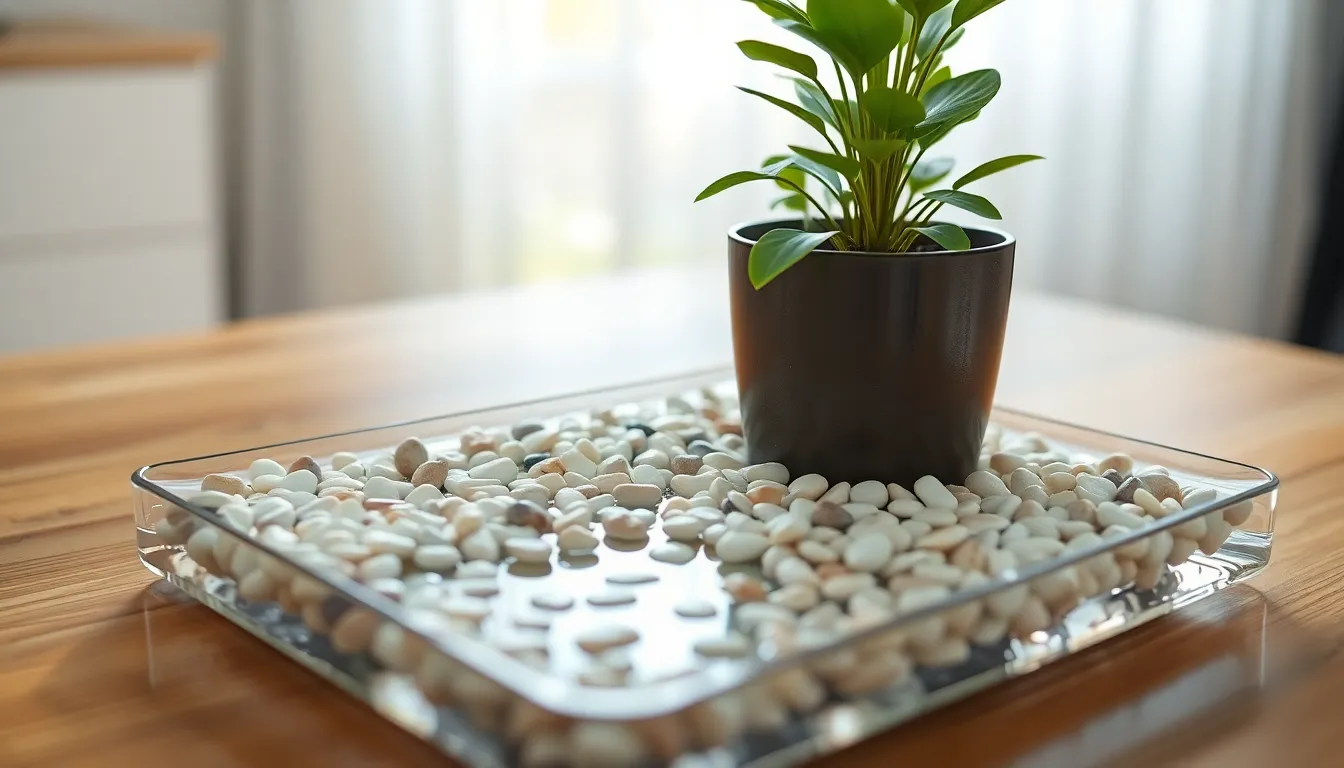
Creating a pebble tray system requires careful attention to container selection, pebble arrangement, and water management. We’ll walk you through each stage to ensure your humidity setup functions effectively for your plants.
Preparing Your Tray and Materials
Select a shallow tray or saucer that extends several inches beyond your plant pot’s base to accommodate the foliage spread. Decorative trays and ordinary plant saucers both work effectively as long as they can hold a base layer of pebbles with water underneath.
Choose small, clean pebbles or rocks from options like natural stones, decorative pebbles, smooth river rocks, or aquarium pebbles. These materials allow proper air circulation above while supporting water retention below your plant container.
Ensure your selected tray depth measures between 1 to 2 inches to prevent water from reaching your plant’s drainage holes. We recommend gathering all materials before beginning the setup process to maintain efficiency.
Arranging Pebbles for Optimal Water Flow
Fill the tray evenly with a single layer of pebbles to create a stable foundation that allows water to pool underneath without covering the stone tops. This arrangement promotes efficient water evaporation while raising humidity levels around your plants.
Position pebbles so they keep your pot elevated above the water line to prevent direct contact between drainage holes and standing water. We’ve found that proper elevation prevents soggy soil conditions and root rot issues.
Space pebbles to allow adequate air circulation between stones while maintaining stability for your plant container. The gaps between pebbles help proper evaporation rates and prevent stagnant water conditions.
Proper Water Level Management
Add water to reach just below the pebble tops to ensure the surface layer remains dry while creating a moist microclimate through evaporation. This water level maintains optimal humidity without saturating your plant’s base.
Check and refill water regularly to prevent the tray from drying out completely, as consistent moisture levels support steady humidity production. We recommend monitoring water levels every few days depending on your indoor conditions.
Clean pebbles and trays periodically to prevent algae buildup and debris accumulation that can impair both function and appearance. Regular maintenance ensures your pebble tray system continues operating effectively.
Consider tray depth and pebble size combinations based on your plant’s humidity needs, as shallow trays with small stones promote faster evaporation for humidity sensitive species. Deeper arrangements retain water longer for steadier moisture distribution around your plants.
Common Mistakes to Avoid When Using Pebble Trays
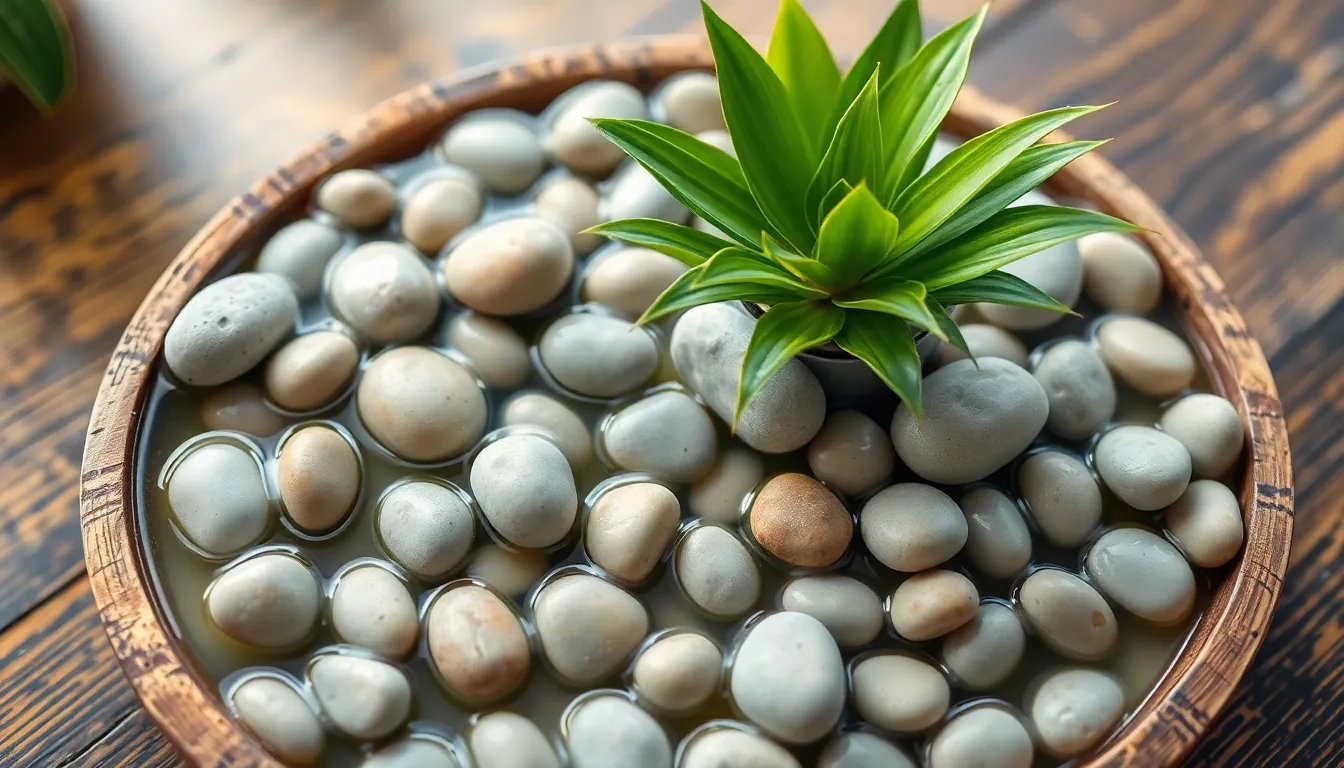
While pebble trays offer excellent humidity answers for houseplants, certain mistakes can undermine their effectiveness or even harm your plants. We’ve identified the most critical errors that plant enthusiasts commonly make when implementing this method.
Overfilling With Water
Keeping the water level too high creates waterlogging conditions that can damage plant roots. We recommend maintaining water levels below the pebble surface to prevent plant pots from sitting directly in standing water. Root rot becomes a serious risk when soil remains constantly saturated from bottom watering through drainage holes.
Proper water depth should measure approximately half the height of your pebbles. This allows adequate evaporation while ensuring the pot base stays dry and well-drained. We suggest checking the water level from the side of the tray to confirm it doesn’t reach the pot’s bottom.
Overfilled trays also reduce air circulation around the root zone. Plants need oxygen at their roots to maintain healthy growth, and waterlogged conditions create anaerobic environments that promote harmful bacteria and fungi.
Using the Wrong Type of Stones
Selecting inappropriate stone materials can reduce your pebble tray’s effectiveness significantly. We advise against using porous stones like lava rock or limestone, which can alter water pH levels and affect sensitive plants. These materials may also leach minerals that accumulate over time and create buildup around your plants.
Clean aquarium gravel and smooth river rocks provide the best results for maintaining consistent humidity. These non-porous options allow proper water evaporation without degrading or releasing unwanted substances into the environment. We recommend stones sized between 0.25 to 0.5 inches in diameter for optimal air circulation.
Dirty or chemically treated stones introduce contaminants that can harm plant health. Always rinse new pebbles thoroughly before use, and avoid decorative stones that may contain dyes or coatings that dissolve in water.
Neglecting Regular Maintenance
Allowing water to stagnate in pebble trays creates breeding grounds for pests and harmful microorganisms. We recommend refreshing the water every 7 to 10 days to prevent mosquito larvae, algae growth, and bacterial development that can affect plant health.
Failing to clean pebbles regularly leads to mineral buildup and reduced evaporation efficiency. Monthly cleaning with warm water removes accumulated salts and debris that can clog spaces between stones and limit proper airflow.
Inconsistent water refilling reduces the humidity benefits your plants receive. We suggest checking water levels twice weekly, especially during heating seasons when evaporation rates increase significantly. Plants that depend on consistent moisture levels may show stress symptoms like brown leaf tips or dropping leaves when humidity fluctuates dramatically.
Maintenance Tips for Long-Lasting Pebble Trays
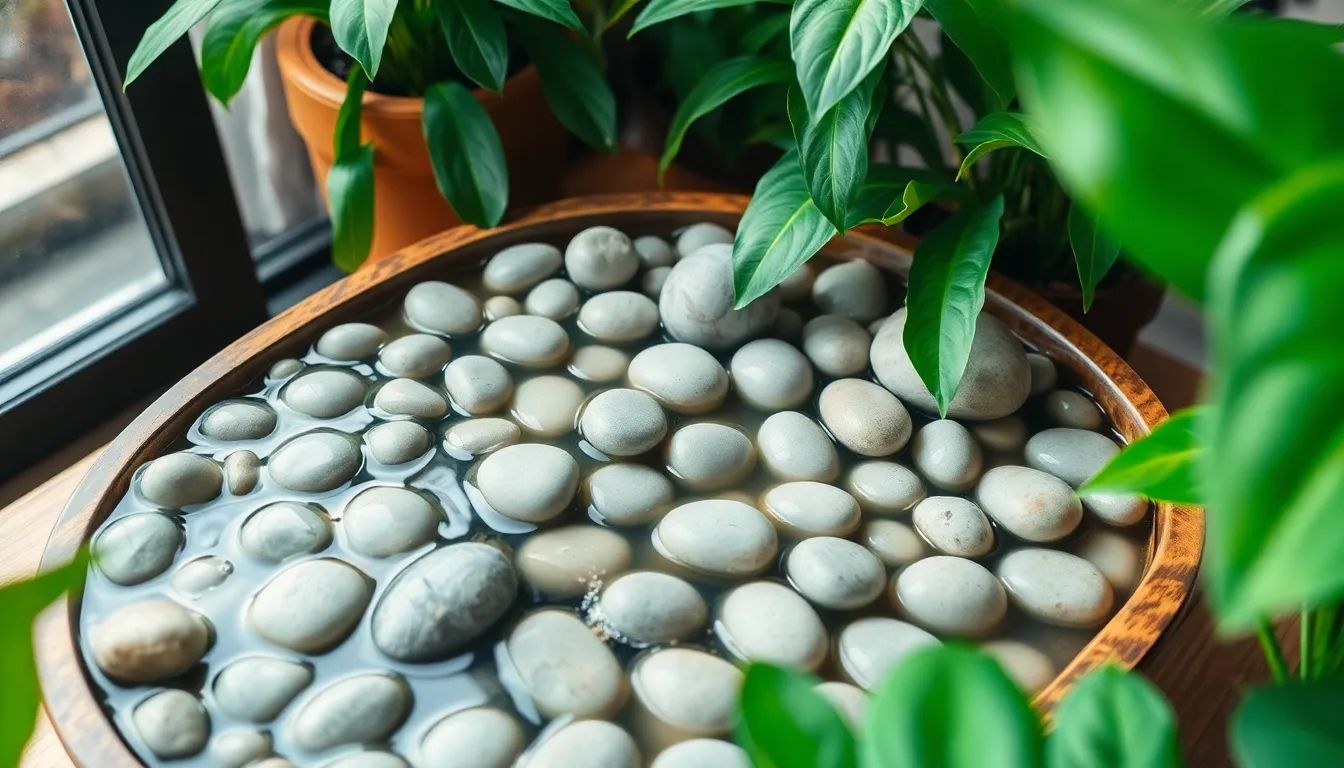
Proper maintenance ensures your pebble trays continue delivering optimal humidity benefits while preventing common issues like mold growth and mineral buildup. Regular care routines keep these humidity systems functioning effectively for years.
Weekly Water Level Checks
Monitor your pebble tray water levels at least once weekly to maintain consistent humidity around your plants. During summer months and hot weather, we recommend checking every 3-4 days since evaporation rates increase significantly with higher temperatures.
Refill the tray when water levels drop below the bottom third of your pebbles to ensure continuous humidity generation. Most plant parents find their refilling schedule aligns naturally with their regular watering routine, making this maintenance step easy to remember.
Environmental factors like heating systems, air conditioning, and seasonal changes can accelerate water loss, requiring more frequent monitoring during these periods. We suggest keeping a small watering can or measuring cup nearby to make quick refills effortless when water levels dip too low.
Cleaning and Sanitizing Procedures
Clean your pebble trays thoroughly every 2-3 weeks to prevent mold, algae, and bacteria buildup that can create unpleasant odors and attract pests. Remove all pebbles from the tray and rinse them under running water to eliminate any accumulated debris or mineral deposits.
Scrub the tray itself with mild dish soap and warm water, paying special attention to corners where organic matter tends to collect. Some gardeners add activated charcoal pieces or antimicrobial stones to their trays between cleanings to naturally reduce mold growth and extend maintenance intervals.
Use distilled or rainwater whenever possible to prevent mineral buildup from tap water, which can impair your tray’s effectiveness over time. If you must use tap water, let it stand overnight before adding it to your tray, allowing chlorine and other chemicals to dissipate naturally.
Seasonal Adjustments for Plant Needs
Adjust your pebble tray maintenance routine based on seasonal humidity changes and your indoor climate conditions. During dry winter months when heating systems reduce indoor moisture levels, increase your monitoring frequency and water replenishment to maintain optimal humidity zones around your tropical plants.
Summer seasons typically require less frequent refilling since natural humidity levels are higher and water evaporation may slow down in more humid environments. We recommend adjusting both tray size and water depth seasonally to ensure your plant’s roots remain elevated above water while maintaining adequate humidity levels.
Monitor your exact plants’ responses to seasonal changes, as varieties like monstera, philodendron, prayer plants, and orchids may need different humidity levels throughout the year. Increase tray capacity during heating season and scale back during naturally humid periods to prevent over-humidification that could encourage fungal issues.
Creative Design Ideas for Decorative Pebble Trays
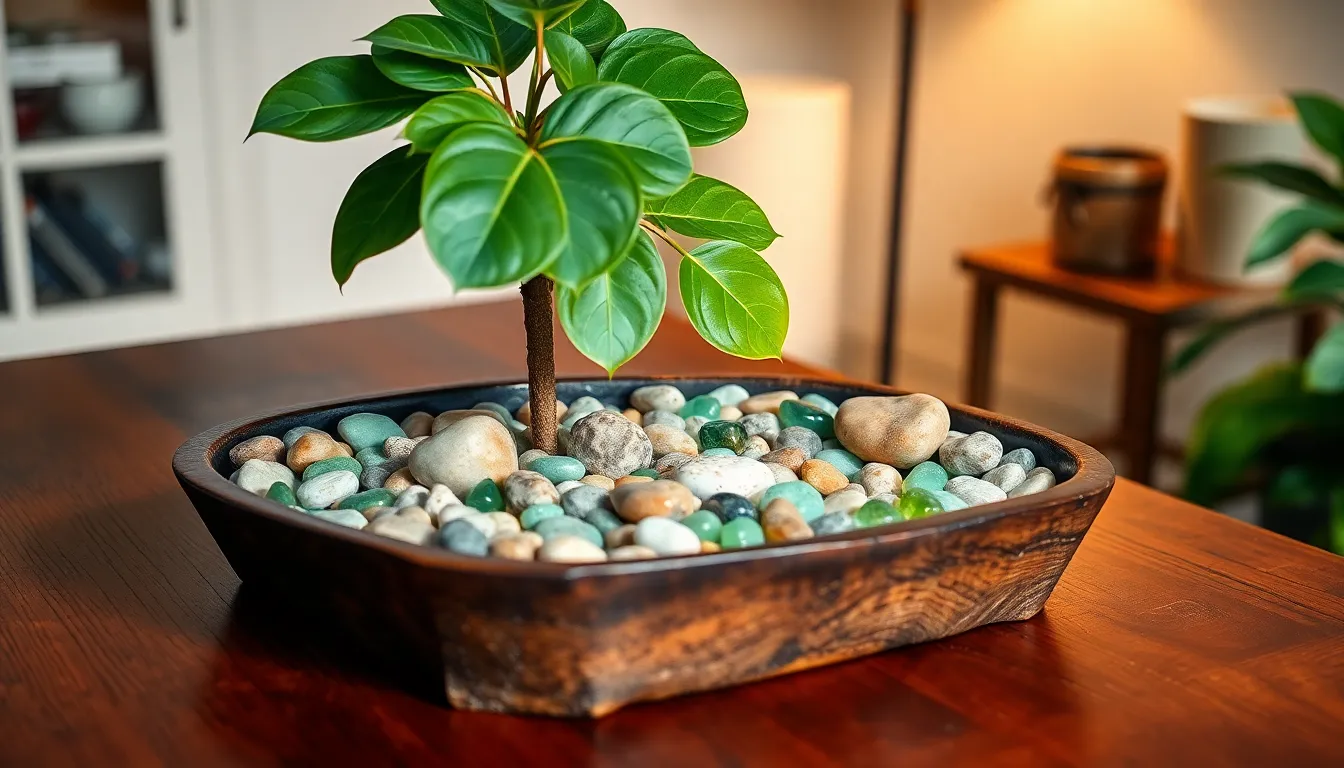
Transforming functional pebble trays into stunning decorative elements lets us enhance our plant displays while maintaining optimal humidity levels. Creative design choices can make these practical tools become beautiful focal points in our indoor gardens.
Color-Coordinated Stone Arrangements
Selecting stones or glass pebbles in exact colors creates visually striking displays that complement our plants and home aesthetics. Green glass pebbles beautifully enhance fiddle leaf figs by adding subtle light-reflecting qualities near windows with indirect light. We can choose contrasting colors to make our plants pop or coordinate tones for a harmonious look throughout our space.
Color coordination extends beyond single hues to include gradient arrangements and pattern designs. Blue glass stones work exceptionally well with silver-leafed plants like dusty miller, while amber-colored pebbles complement golden pothos varieties. Mixing different sized stones in the same color family adds visual depth without overwhelming the natural beauty of our plants.
Incorporating Natural Elements
Natural river rocks and beach glass provide authentic textures that connect our indoor spaces with outdoor environments. River rocks work particularly well for larger trays and create rustic vibes that complement farmhouse or cottage decor styles. We can collect these materials from nature walks or repurpose stones from previous landscaping projects to add personal meaning to our plant displays.
Beach glass and smooth river stones offer tactile interest while maintaining the functional benefits of traditional pebble trays. These natural elements weather beautifully over time, developing patinas that enhance their organic appeal. Driftwood pieces can serve as accent elements alongside stones, creating miniature industry scenes around our humidity-loving plants.
Matching Trays to Home Decor Styles
Choosing creative base containers from everyday household items ensures our pebble trays seamlessly integrate with existing decor themes. Vintage saucers, decorative bowls, ceramic pie plates, and wooden trays can all serve as stylish foundations for our humidity systems. Even repurposed items like attractive dog dishes or baking dishes can become conversation pieces when filled with coordinated stones.
Modern minimalistic settings benefit from simple glass or ceramic trays paired with uniform pebbles in neutral tones. Rustic and boho styles shine with wooden trays containing rough, varied stones that emphasize natural textures. We can select containers that either blend subtly into our decor or stand out as intentional design statements while maintaining their practical humidity-boosting functions.
Alternative Methods to Pebble Trays for Plant Humidity
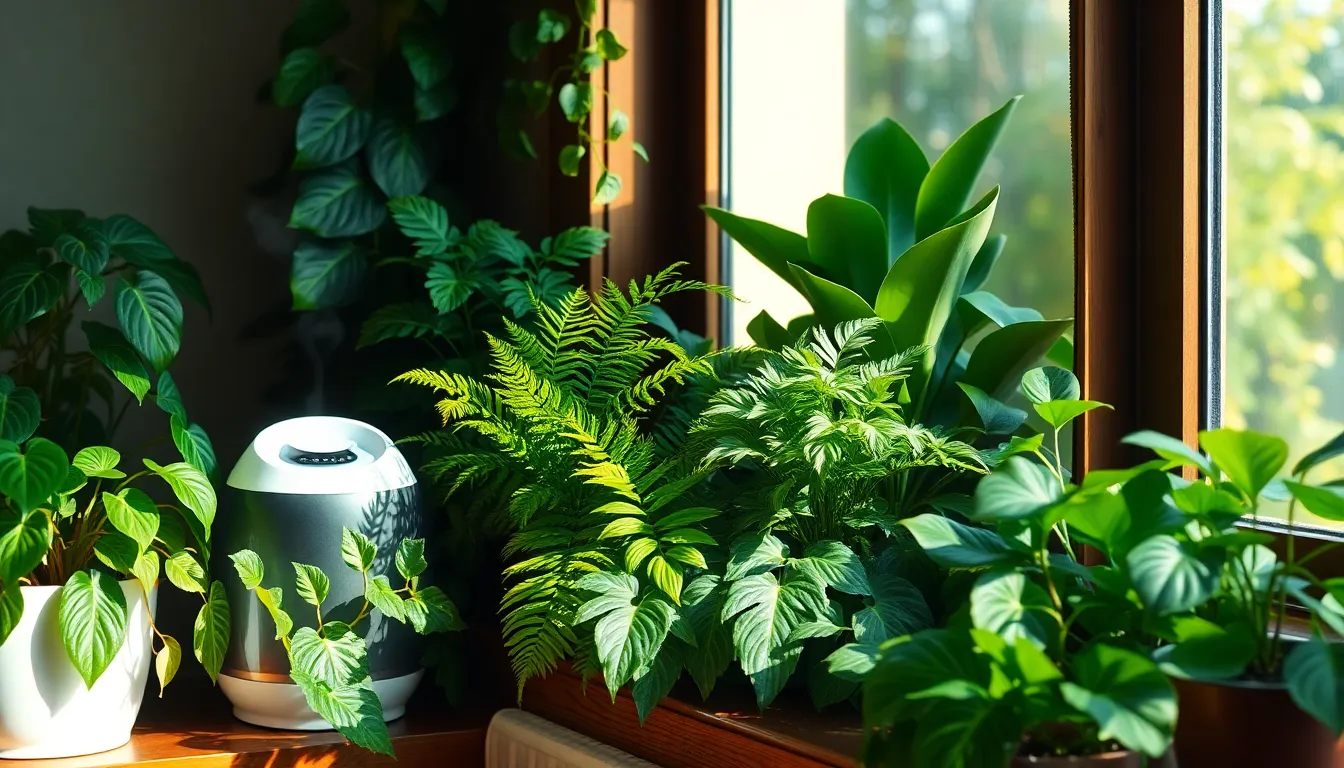
While pebble trays offer a simple approach to humidity enhancement, several other methods can provide more substantial moisture increases for our indoor plants.
Electric Humidifiers vs. Pebble Trays
Electric humidifiers mechanically release water vapor into the air, creating controlled and consistent humidity increases across larger areas than pebble trays can achieve. Research shows that pebble trays only raise humidity by 2-3% in their immediate vicinity, with negligible effects beyond one foot away. Humidifiers can boost room humidity by substantial percentages, making them ideal for tropical plants requiring steady moisture levels between 40-60%.
Control becomes a important advantage with electric humidifiers, as we can adjust settings to maintain precise humidity levels throughout the day. Pebble trays provide eco-friendly simplicity without electricity requirements, but they can’t match the coverage area or consistency that mechanical humidifiers deliver. Coverage area differences make humidifiers more practical for multiple plants spread across rooms, while pebble trays work best for individual plant groupings.
Grouping Plants Together
Clustering multiple plants creates natural microenvironments where transpiration from leaves accumulates to increase local humidity levels. This method proves more effective than individual pebble trays because several plants release moisture simultaneously in the same area. Strategic placement of humidity-loving species like ferns, pothos, and prayer plants together maximizes this transpiration effect.
Dense groupings work particularly well in corners or near windows where air circulation naturally distributes the collective moisture. Plants benefit from each other’s water vapor release, creating a community effect that sustains higher humidity levels throughout the day. Arrangement considerations include ensuring adequate light reaches all plants while maintaining close enough proximity for humidity sharing.
Misting and Other Natural Answers
Misting involves spraying plants with fine water droplets to temporarily raise humidity around foliage, though this method provides only short-lived benefits as water quickly evaporates. Direct application to leaves can increase moisture levels briefly, but frequent misting may encourage fungal growth on sensitive plants. Timing misting sessions during morning hours allows plants to absorb moisture before temperatures rise.
Water features like small fountains or bowls placed near plants create continuous evaporation sources that outperform static pebble trays. Wet sphagnum moss wrapped around pot bases provides sustained moisture release while improving the aesthetic appeal of plant displays. Bathroom and kitchen placement takes advantage of naturally humid environments created by daily activities like showering and cooking.
Natural approaches offer cost-effective answers, though they typically deliver localized or temporary humidity increases rather than the sustained moisture levels that tropical plants require for optimal growth.
Cost-Effective DIY Pebble Tray Projects
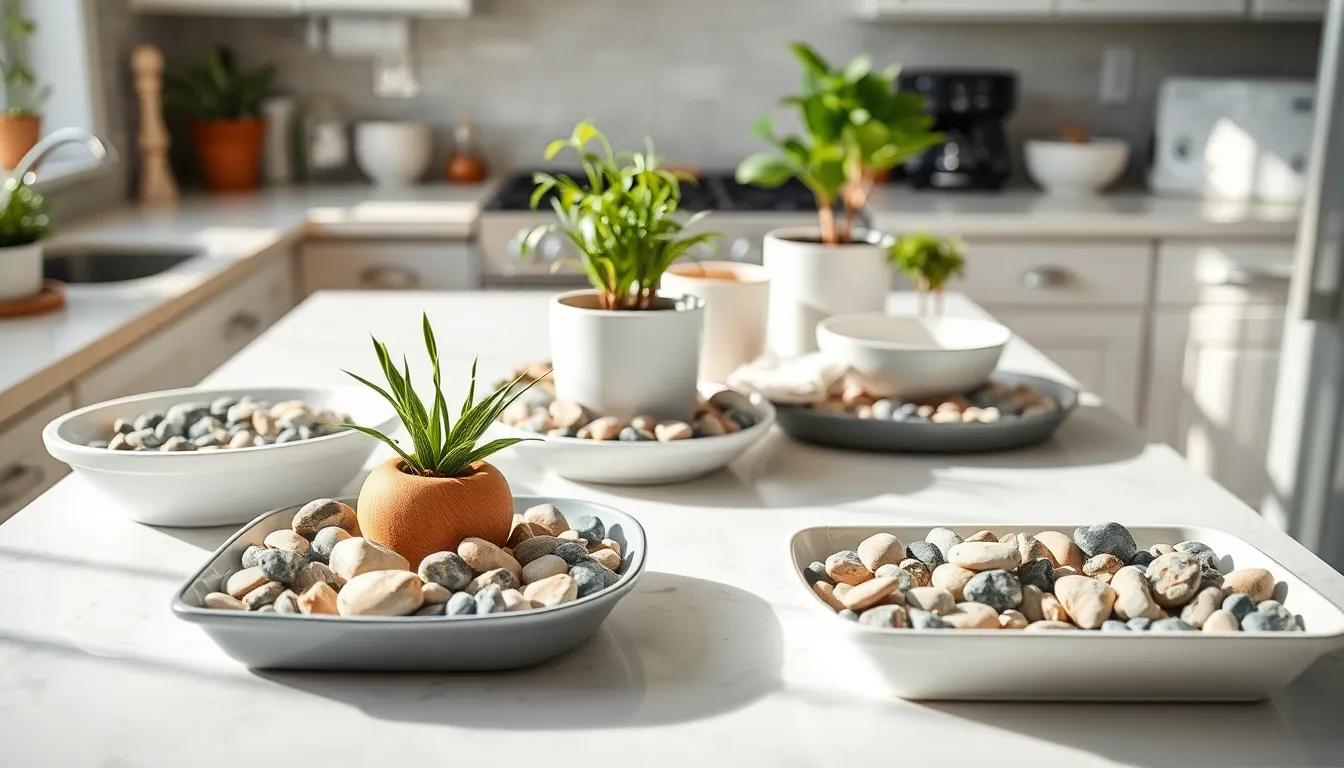
Building pebble trays doesn’t require expensive specialty items when you’ve got creative alternatives right in your home. We’ll show you how to transform everyday household materials into effective humidity answers that work just as well as store-bought options.
Using Household Items as Trays
Shallow baking sheets make excellent pebble tray bases since they’re already designed to hold liquids without leaking. We often repurpose old cookie sheets, rimmed baking pans, and roasting trays that have seen better days in the kitchen. Plant saucers you already own can serve double duty as both drainage catchers and humidity enhancers.
Plastic food storage containers work perfectly when you need custom sizes for exact plant arrangements. Large yogurt containers, takeout lids, and shallow tupperware pieces create instant trays without any additional cost. Ceramic dishes like pie plates and serving platters add an elegant touch while functioning as effective humidity bases.
Glass baking dishes provide a clean, professional look that complements modern home decor. We recommend using rectangular casserole dishes or round pie plates depending on your space and plant grouping needs. Old television dinner trays and cafeteria-style compartment plates can accommodate multiple small plants in one organized setup.
Budget-Friendly Pebble Sources
Natural collection sites offer free pebbles when local regulations permit gathering small stones. Rivers, streams, and lake shores provide smooth, water-worn rocks that work perfectly for plant humidity needs. Beach areas yield beautiful rounded stones, though we always check local collection rules before taking any materials.
Create stores sell decorative stones in small bags at reasonable prices, especially during seasonal sales. Dollar stores often stock aquarium gravel and decorative pebbles for a fraction of garden center costs. Hardware stores carry construction gravel that works well after a thorough cleaning to remove dust and debris.
Aquarium supply shops provide clean, pH-neutral stones specifically designed for water environments. Pet stores offer various sized gravels originally intended for fish tanks but perfect for plant trays. Garden centers frequently have bulk stone options where you can purchase exactly the amount needed without buying oversized bags.
Upcycling Materials for Eco-Friendly Options
Broken pottery pieces create unique drainage layers when edges are smoothed for safety. We save chipped ceramic bowls, cracked flower pots, and damaged tiles to repurpose as attractive pebble alternatives. Glass fragments from bottles and jars work well after tumbling or careful edge smoothing to prevent cuts.
Plastic bottle caps accumulate quickly in most households and float perfectly to indicate water levels. Corks from wine bottles provide natural, biodegradable options that won’t affect water chemistry. Small wooden pieces like create blocks or old game pieces add organic texture while serving functional drainage purposes.
Metal items such as clean bottle caps, decorative buttons, and unused washers create industrial-style humidity trays. We’ve successfully used clean pebbles from old concrete projects and decorative stones from discontinued crafting supplies. Marbles collected from various sources make colorful, easy-to-clean alternatives that children often enjoy helping arrange.
Conclusion
Pebble trays offer us a simple yet powerful way to transform our indoor gardening experience. We’ve explored how these affordable humidity answers can make the difference between struggling plants and thriving green companions.
The beauty of pebble trays lies in their versatility and accessibility. Whether we’re caring for delicate orchids or robust tropical houseplants our pebble tray setups can be customized to meet each plant’s exact needs.
With minimal investment and basic maintenance we can create the ideal microclimate for our beloved plants. From DIY projects using household items to decorative designs that complement our home decor pebble trays prove that effective plant care doesn’t have to be complicated or expensive.
Start with one or two pebble trays and watch how this simple addition elevates your plant care routine and transforms your indoor garden into a healthier more vibrant space.
Frequently Asked Questions
What are pebble trays and how do they work?
Pebble trays are shallow containers filled with stones or pebbles and water that increase humidity around houseplants. They work through evaporation – as water slowly evaporates from the tray, it raises moisture levels in the immediate area, creating a beneficial microclimate that mimics natural growing conditions for your plants.
Which plants benefit most from pebble trays?
Tropical houseplants like pothos, philodendrons, and monstera thrive with pebble trays. Orchids and air plants also respond positively since they get necessary moisture without waterlogged roots. Ferns, prayer plants, and calatheas show significant health improvements when humidity levels are increased through this method.
What materials do I need to create a pebble tray?
You need a shallow container (1-2 inches deep), smooth non-porous pebbles or stones like river rocks or aquarium gravel, and clean distilled or filtered water. Avoid calcium-rich stones that can alter water pH. Suitable containers include plant saucers, shallow dishes, or even repurposed household items.
How often should I maintain my pebble trays?
Check water levels weekly and refill as needed. Clean the trays and refresh water every 7-10 days to prevent stagnation and contamination. Clean pebbles monthly to remove mineral buildup and algae. During dry winter months, you may need to monitor and refill more frequently.
What mistakes should I avoid when using pebble trays?
Don’t overfill trays with water, as this can cause root damage and reduce air circulation. Avoid using inappropriate stones that alter water pH. Never let plant pots sit directly in standing water. Regular maintenance is crucial – stagnant water can lead to mold growth and pest problems.
How much do pebble trays increase humidity?
Pebble trays typically increase humidity by 2-3% in their immediate vicinity, creating localized moisture zones around plants. While this may seem modest, it’s often sufficient to help plants maintain optimal humidity levels between 40-60%, especially during dry winter months when indoor heating reduces moisture.
Are there alternatives to pebble trays for increasing humidity?
Yes, alternatives include electric humidifiers (which can significantly increase room humidity), grouping plants together to create natural microenvironments, misting, water features, and using wet sphagnum moss. However, pebble trays offer a cost-effective, low-maintenance solution that provides consistent localized humidity.
Can I make pebble trays using household items?
Absolutely! You can use shallow baking sheets, old cookie sheets, plastic food storage containers, or even repurposed plates as trays. For pebbles, consider collecting stones from natural sources, using items from dollar stores, or upcycling materials like broken pottery or plastic bottle caps.

